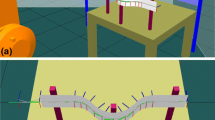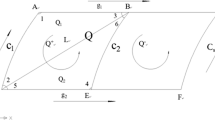Abstract
The torch speed is one of the most important operating parameters in thermal spraying. Generally, in order to keep a uniform coating thickness, the movement of the torch should be constant. Nevertheless, when the torch follows a large trajectory angle, the torch speed will decrease significantly, which leads to an irregular coating thickness. This phenomenon is caused by the weight of different devices fixed on the robot and the combination of the robot’s six axes. It is therefore necessary to optimize robot kinematics behaviors in this case. In this paper, the works concentrate mainly on the relationship between the robot kinematics property and the coating quality to find an adequate model for the torch speed optimization. An add-in program based on RobotStudio™ (ABB, Sweden) is developed to determine and optimize the spray trajectory. The optimal trajectory was verified by both the simulations and the experiments.














Similar content being viewed by others
References
Z.Y. He, D.B. Zhu, Y.P. Tang, and B.H. Lu, A Novel Arc Spraying Robot for Rapid Tooling, Int. J. Adv. Manuf. Technol., 2006, 31(9-10), p 1012-1020
A. Candel and R. Gadow, Optimized Multiaxis Robot Kinematic for HVOF Spray Coatings on Complex Shaped Substrates, Surf. Coat. Technol., 2006, 201(5), p 2065-2071
J.L. Fuller, Robotics: Introduction, Programming, and Projects, 2nd ed., Prentice-Hall, Upper Saddle River, NJ, 1999
Lozano-Perez, Robot Programming Technical Report Memo 698, Proceedings of the IEEE, Vol 71, July 1983
L.W. Tsai, Robot Analysis: The Mechanics of Serial and Parallel Manipulators, Wiley, New York, 1999
ABB, RobotStudio™ Users Guide, Sweden, 2002
S. Deng, H. Liao, and C. Coddet, Robotic Trajectory Autogeneration in Thermal Spraying, Thermal Spray: Explore its Potential!, E. Lugscheider, Ed., May 2-4, 2005 (Basel, Switzerland), ASM International, 2005, p 481-485
S. Deng, H. Liao, C. Zeng, P. Charles, and C. Coddet, Development of Robotic Trajectories Auto Generation in Thermal Spraying: A New Extended Program of ABB RobotStudio™, Les deuxiemes rencontres Internationale sur la projection thermique, 2005 (Lille France), 2005, p 97-104
S. Deng, H. Liao, R. Bonnet, C. Zeng, and C. Coddet, Real Time Monitoring of Robot Trajectory in Thermal Spraying, Thermal Spray: Advances in Technology and Application, May 10-12, 2004 (Osaka, Japan), ASM International, 2004
Z. Govindarajulu, Elements of Sampling Theory and Methods, Prentice Hall, Upper Saddle River, NJ, 1999
W.S. George and G.C. William, Statistical Methods, 8th ed., Wiley-Blackwell, 1989
Author information
Authors and Affiliations
Corresponding author
Rights and permissions
About this article
Cite this article
Fang, D., Deng, S., Liao, H. et al. The Effect of Robot Kinematics on the Coating Thickness Uniformity. J Therm Spray Tech 19, 796–804 (2010). https://doi.org/10.1007/s11666-010-9470-7
Received:
Revised:
Published:
Issue Date:
DOI: https://doi.org/10.1007/s11666-010-9470-7




